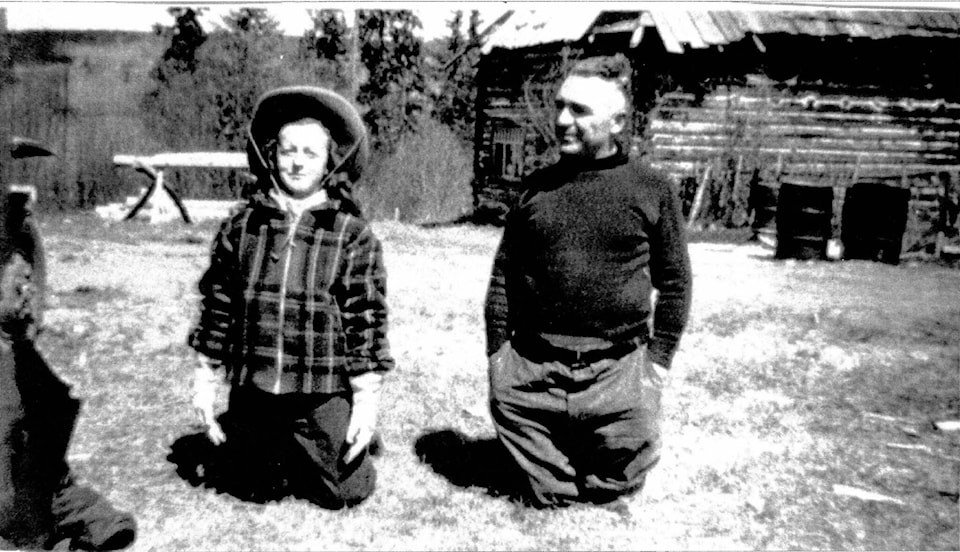You would never know it today, but there was once a thriving community at the west end of Francois Lake.
Long before the first white men arrived, a number of First Nations families (including Matthew Sam, Jimmy Antoine, and others) lived near the mouth of the Nadina River, but the first European settlers didn’t show up until the turn of the 20thCentury. William (Bill) Bickle and his brother Frank passed through in 1907, but it wasn’t until 1910 that a man named Mike Gallagher built a cabin at the west end of Francois Lake.
Gallagher worked on the Grand Trunk Pacific Railway. Every spring, he left his homestead and walked out to Houston in search of employment. In the fall, he returned home with a wheelbarrow full of supplies – enough, he hoped, to last the winter.
The first store at Nadina, if it could be called that, was established by a man named Mosher in 1913. His stock was limited to a few axe handles, some rice, and flour, so most people looked elsewhere for supplies. All that changed in 1918, though, when Frank Gale and his family arrived and took up residence.
Frank bought furs from local trappers and established a trading post on the lakeshore. When that structure burnt down, he built a new home and store on a hillside above the lake’s south shore.
The Gale store became the nucleus of a new community. More settlers arrived, enough to support a school, a dance hall, and a post office. By 1927, Frank was advertising in the Burns Lake newspaper, making regular trips to the village for supplies, and even ferry passengers up and down Francois Lake in what the Observer newspaper described as a “speed boat.” He also had a scow, and used it to transport everything from supplies to Mike Touhy’s threshing machine.
The Gales were a hospitable lot. A man named Tom Thompson (no relation to the Group of Seven painter) maintained what passed for roads in the Nadina area. One winter’s night, when the temperature dipped to -60 Fahrenheit, he sought refuge at the Gale store.
Frank’s father, an eccentric fellow known to all as “Old Man Gale,” gave Thompson a room in the store. The road worker remarked later that while the bedsheets were clean, Old Man Gale did not provide his lodger with any blankets. Thompson almost froze to death. It was, he said, so cold in the building the following morning that his host cooked had to wear mitts while cooking breakfast.
The community at Nadina continued to grow. Settlers eventually got around to building a bridge at the west end of Francois Lake, but the lake itself was the most reliable transportation route. By March 15, 1928, there were so many boats using the west end of Francois Lake between April and December that Frank urged the Burns Lake Board of Trade to lobby for the establishment of several wharves in the area. At least one senior level of government felt the request was warranted, because a new government wharf was built not far from the Gale store.
The fledgling community narrowly escaped disaster in June 1932, when a forest fire swept through the area, but residents from as far away as Wistaria came to the rescue.
“District Forester Parlow and Forest Ranger Pedley put in a strenuous time fighting the Owen Lake fire when it swept into the Nadina River settlement,” Sidney Godwin wrote in the Observer, Burns Lake’s weekly newspaper. “Mr. Parlow came in to Burns Lake at the week end exhausted from unremitting toil and lack of sleep. He is loud in his praise of the Wistaria residents, including Arthur Shelford and Pete Kerr, who came for many miles and offered their cooperation in the fight to save Frank Gale’s store buildings and stock, and the Nadina settlement. Had it not been for their timely arrival, willing work, and direction of the wind, the Nadina River settlement would have been completely wiped out.”
Nadina survived the fire, but not the Great Depression. Desperate for work, many residents moved away. The post office closed, and eventually the store and school did, too. Frank Gale and his family were among the last to leave; they sold their property to a man named Carl Osborne and moved to Victoria. Their former home and store burned to the ground on November 8, 1947, and were not rebuilt.
Today, Frank Gale’s stone chimney and a few pilings in Francois Lake (vestiges of the government wharf) mark the site of what was once the thriving community of Nadina. Both are visible from Ootsa-Nadina Road, which was swept by wildfire again in 2018.
© 2021 Michael Riis-Christianson and the Lakes District Museum Society
